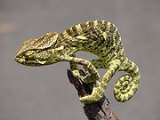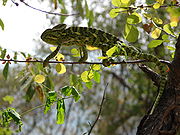
Chamaeleo zeylanicus
Encyclopedia
The Indian Chameleon, Chamaeleo zeylanicus is a species of chameleon
found in Sri Lanka
, India
and other parts of South Asia
. Like other chameleons, this species has a long tongue, feet that are shaped into bifid claspers, a prehensile tail
, independent eye movement and the ability to change skin colour. They move slowly with a bobbing or swaying movement and are usually arboreal. Strangely, they do not choose the background colour and may not even be able to perceive colour differences. They are usually in shades of green or brown or with bands. They can change colour rapidly and the primary purpose of colour change is for communication with other chameleons and for controlling body temperature by changing to dark colours to absorb heat.
Type locality: Sri Lanka
, restricted by Mertens in 1969.
 The head has a bony casque, ornamented with crests or tubercles. A separation between the eyes, the interorbital septum, is present. Pre-maxillary extremely small, edentulous; orbit bony all round, the pre- and post-frontals often joining to form a supraorbital roof; a pair of supra-nasal fontanelles, bordered by the nasals, the prefrontals, and the frontal; the latter bone single; parietal single, often much narrowed and compressed, forming a crest, and meeting posteriorly the extremities of the squamosals. Dentition acrodont; teeth compressed, triangular, more or less distinctly tricuspid. Palate toothless. Eye large, covered by a thick granular lid pierced with a small central opening for the pupil. No tympanum or external ear. Body compressed; neck very short. Vertebrae procoelian. Abdominal ribs present. Limbs long, raising the body. Digits arranged in bundles of 2 and 3; in the hand, the inner bundle is formed of three, the outer of two digits; it is the reverse in the foot. Tail prehensile. Head and body covered with granules or tubercles.
The head has a bony casque, ornamented with crests or tubercles. A separation between the eyes, the interorbital septum, is present. Pre-maxillary extremely small, edentulous; orbit bony all round, the pre- and post-frontals often joining to form a supraorbital roof; a pair of supra-nasal fontanelles, bordered by the nasals, the prefrontals, and the frontal; the latter bone single; parietal single, often much narrowed and compressed, forming a crest, and meeting posteriorly the extremities of the squamosals. Dentition acrodont; teeth compressed, triangular, more or less distinctly tricuspid. Palate toothless. Eye large, covered by a thick granular lid pierced with a small central opening for the pupil. No tympanum or external ear. Body compressed; neck very short. Vertebrae procoelian. Abdominal ribs present. Limbs long, raising the body. Digits arranged in bundles of 2 and 3; in the hand, the inner bundle is formed of three, the outer of two digits; it is the reverse in the foot. Tail prehensile. Head and body covered with granules or tubercles.
Casque much elevated posteriorly, with strong curved parietal crest; the distance between the commissure of the mouth and the extremity of the casque equals or nearly equals the distance between the end of the snout and the hinder extremity of the mandible; no rostral appendages; a strong lateral crest, not reaching the end of the parietal crest; an indication of a dermal occipital lobe on each side, not reaching the parietal crest. No enlarged tubercles on the body; a feebly serrated dorsal crest; a series of conical tubercles form a very distinct crest along the throat and belly. Male with a tarsal process or spur, Tail longer than head and body. Gular-ventral crest white; commissure of the mouth white.
From snout to vent 7 inches long with a prehensile tail of 8 inches.
Chameleon
Chameleons are a distinctive and highly specialized clade of lizards. They are distinguished by their parrot-like zygodactylous feet, their separately mobile and stereoscopic eyes, their very long, highly modified, and rapidly extrudable tongues, their swaying gait, the possession by many of a...
found in Sri Lanka
Sri Lanka
Sri Lanka, officially the Democratic Socialist Republic of Sri Lanka is a country off the southern coast of the Indian subcontinent. Known until 1972 as Ceylon , Sri Lanka is an island surrounded by the Indian Ocean, the Gulf of Mannar and the Palk Strait, and lies in the vicinity of India and the...
, India
India
India , officially the Republic of India , is a country in South Asia. It is the seventh-largest country by geographical area, the second-most populous country with over 1.2 billion people, and the most populous democracy in the world...
and other parts of South Asia
South Asia
South Asia, also known as Southern Asia, is the southern region of the Asian continent, which comprises the sub-Himalayan countries and, for some authorities , also includes the adjoining countries to the west and the east...
. Like other chameleons, this species has a long tongue, feet that are shaped into bifid claspers, a prehensile tail
Prehensile tail
A prehensile tail is the tail of an animal that has adapted to be able to grasp and/or hold objects. Fully prehensile tails can be used to hold and manipulate objects, and in particular to aid arboreal creatures in finding and eating food in the trees...
, independent eye movement and the ability to change skin colour. They move slowly with a bobbing or swaying movement and are usually arboreal. Strangely, they do not choose the background colour and may not even be able to perceive colour differences. They are usually in shades of green or brown or with bands. They can change colour rapidly and the primary purpose of colour change is for communication with other chameleons and for controlling body temperature by changing to dark colours to absorb heat.
Distribution
They are found in India, South of the Ganges river.Type locality: Sri Lanka
Sri Lanka
Sri Lanka, officially the Democratic Socialist Republic of Sri Lanka is a country off the southern coast of the Indian subcontinent. Known until 1972 as Ceylon , Sri Lanka is an island surrounded by the Indian Ocean, the Gulf of Mannar and the Palk Strait, and lies in the vicinity of India and the...
, restricted by Mertens in 1969.
Description

Casque much elevated posteriorly, with strong curved parietal crest; the distance between the commissure of the mouth and the extremity of the casque equals or nearly equals the distance between the end of the snout and the hinder extremity of the mandible; no rostral appendages; a strong lateral crest, not reaching the end of the parietal crest; an indication of a dermal occipital lobe on each side, not reaching the parietal crest. No enlarged tubercles on the body; a feebly serrated dorsal crest; a series of conical tubercles form a very distinct crest along the throat and belly. Male with a tarsal process or spur, Tail longer than head and body. Gular-ventral crest white; commissure of the mouth white.
From snout to vent 7 inches long with a prehensile tail of 8 inches.
External links
- http://itgmv1.fzk.de/www/itg/uetz/herp/photos/Chamaeleo_zeylanicus.jpg
- http://itgmv1.fzk.de/www/itg/uetz/herp/photos/Chamaeleo_zeylanicus1.jpg
- Sri Lankan Reptiles @ The University of Peradeniya Department of Zoology

